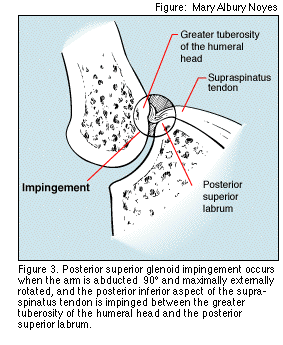 INJURIES
INJURIES 
Many injuries
occur at the shoulder joint. Many of them are due to over use and chronic
fatigue of the rotator cuff muscles. These injuries are especially common
with athletes that do repetitive over-head arm movements,
such as swimmers,
pitchers and volleyball players.
This
page is focused on injuries at the shoulder joint of swimmer athletes,
specifically "Swimmer's Shoulder".
Statistics:
Shoulder pain is the hallmark of swimmer's shoulder and is the most common
musculoskeletal complaint among competitive swimmers. Up to 35% of competitive
swimmers report of having present interfering shoulder pain, and up to
75% of competitive swimmers have a history of shoulder pain.
History:
"Swimmer's Shoulder" was first detected in 1974 as a common, painful syndrome
of repeated shoulder impingement in swimmer athletes. The term "swimmer's
shoulder" generally refers to subacromial impingement syndrome and related
dysfunction in swimmers. It is most common with the freestyle
and butterfly strokes, but can also occur with backstroke, and irritated
with breaststroke.
Definition:
"Swimmer's shoulder" is often a chronic injury due to overuse, shoulder
laxity and muscle fatigue of the rotator cuff muscles and the scapular
stabilizers, from repetitive overhead activities. It is also known as "impingement
syndrome" of the rotator cuff, and involves inflammation of the subacromial
bursa, supraspinatus and long head biceps tendons, and the coracoacromial
arch. This includes the acromion, the acromioclavicular joint, the coracoid
process, and the coracoacromial ligament, all of which form a roof over
the supraspinatus tendon. As the humerus moves through its complete range
of motion, in an overhead arch, the soft tissues of the subacromial space
are compressed between the head of the humerus and the coracoacromial arch
and the anterior acromion. As these tissues become inflamed, the narrow
space becomes even tighter, thus continuing to increase irritation and
inflammation, worsening the impingement.
Swimming Freestyle:
Swimming is a repetitive activity that takes the arms through complete
range of motion at the shoulder joint. Freestyle and butterfly are strokes
that most commonly cause "swimmer's shoulder." The freestyle
stroke consists of a pull-through phase while the arm is in the water,
which provides propulsion, and a recovery phase in which the arm is above
the water. In this stroke, which most swimmers use for the majority of
training, the shoulder is subject to impingement when the shoulder is in
the early to mid pull-through phase, which involves extreme adduction and
internal rotation. The extremely abducted arc of the recovery phase also
produces impingement, as the humeral head is brought against the lateral
acromion.
If the average swimmer swims 10,000 yards daily, estimating 10 cycles for
every 25 yards, there would be a total of 4,000 repetitions per shoulder
on a daily basis.
Muscles Involved:
During the pull-through phase of the freestyle stroke, the subscapularis
is the main muscle of the rotator cuff that is being fatigued. During the
recovery phase the supraspinatus, infraspinatus and teres minor are very
active. All of these four muscles, because they are small, get fatigued
very quickly. As they fatigue, they are not able to complete their main
purpose and function, which is to keep the head of the humerus in the glenoid
cavity. When this occurs, the soft tissue at the shoulder joint become
impinged and inflamed.
Other Problems:
There are many other problems that occur at the shoulder joint for swimmers
and usually come hand-in-hand with "should impingement syndrome." These
are tendonitis and bursitis of the shoulder. Usually the tendonitis occurs
at the subscapularis and biceps brachii long head tendons because they
are constantly being irritated. Bursitis usually occurs when the subacromial
bursae becomes inflamed from impingement.

These problems can be prevented if the athlete dedicates time to taking precautionary preventative measures such as: icing after practices, doing strengthening exercises at least once a day, and stopping when there is any feeling of strange pain in the shoulder area. If the athlete reports the pain to a trainer immediately, then the trainer will be able to help the athlete in prevention of a more serious injury.
Laina Hovsepian
SPME 400
Dept. of Sports Medicine, Pepperdine University